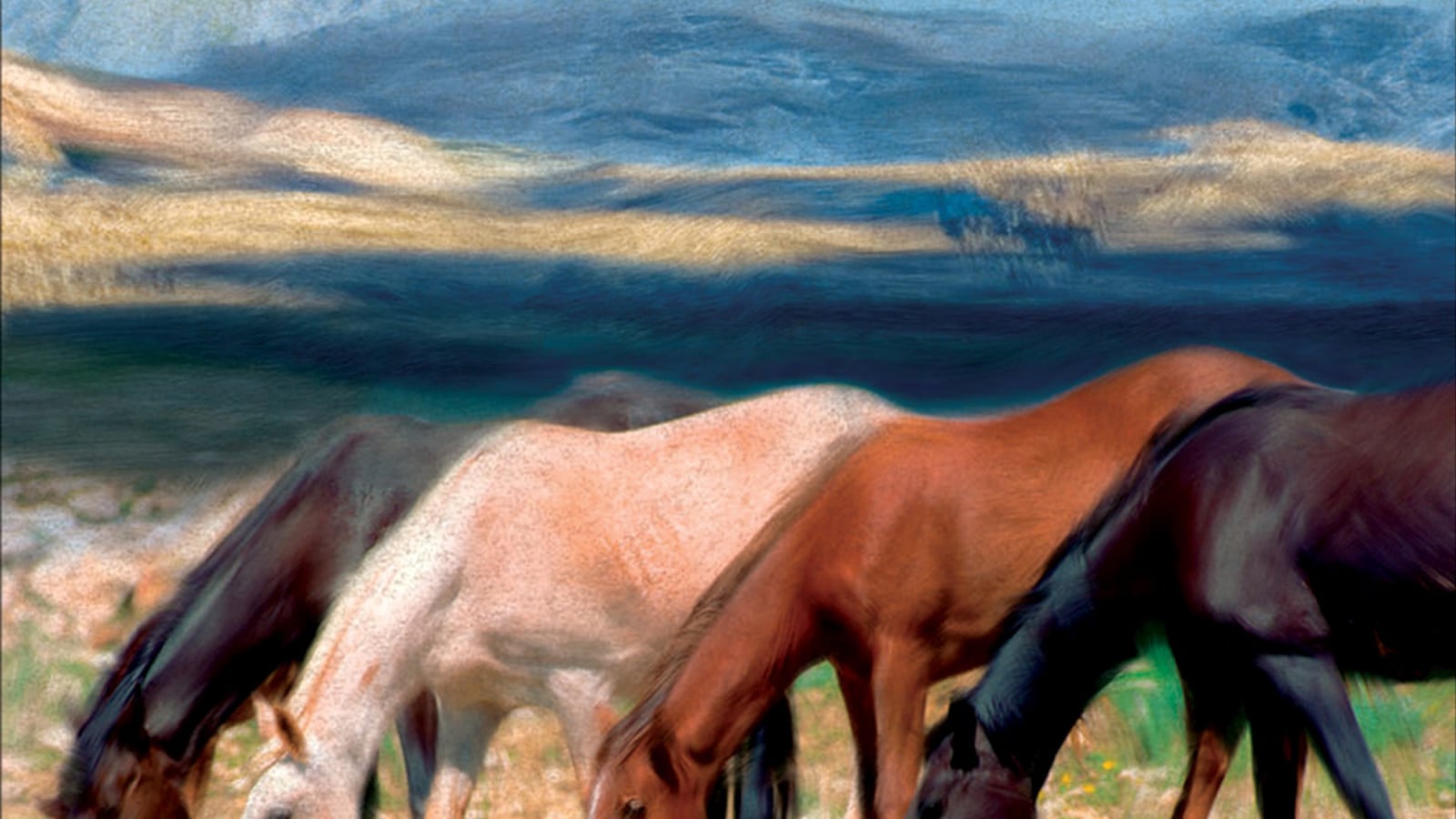The past echoes through the canyons of the West in this richly layered first novel. In Painted Horses, Malcolm Brooks surrounds his two loss-haunted protagonists with a chorus of voices claiming history as living memory, handed down through the generations. Mythic resonances are inevitable when moving through a landscape so central to the American self-image, but Brooks counters the legends with the actual experiences of people who were there.
A Native American teenager recounts her great-grandfather’s lucky escape on the morning of Greasy Grass (“what you call Custer’s Last Stand”), when the general dismissed his Indian scouts for having the audacity to warn him his army was vastly outnumbered. A Basque shepherd on the Montana range in 1930 recalls his Scots employer’s account of the terrible winter of 1886, frigid refutation of blithe Chamber of Commerce-style assurances that America’s “vast and empty middle continent [was] ripe with agricultural promise.” The reality of life in the West is harder and more complicated than the myth.
Catherine Lemay is impressed by neither the myth nor the reality when she arrives in Montana in the summer of 1956. She’s an archaeology graduate student recently returned from a dig in London, where World War II bombings exposed strata of civilizations dating back to ancient Rome: “American archaeology didn’t and couldn’t deal with civilizations, not as she regarded the term.” But the Smithsonian is so desperate for personnel on its River Basin Surveys that it’s even hiring women, and Catherine is equally desperate to evade the straitjacket her parents expect her to don: marriage, babies, dinner parties. She doesn’t initially care that her survey is a pro-forma exercise to enable Harris Power and Light to build a dam over the objections of local Crow Indians who regard the canyon about to be flooded as a sacred site. “Your work will illuminate the mission of progress,” asserts the dam’s builder, and the frustrating conclusion of Catherine’s work in London convinced her the forces of progress are unstoppable.
Unstoppable or not, John H has seen little in his 38 years to persuade him progress is benign. When he was a teenager, a federal law that fenced in public lands destroyed the livelihood of Jean Bakar, the kindly shepherd who took him in as a starving runaway. The need to support his shattered mentor forced John to channel his natural ability with horses into work rounding up wild herds to be turned into modern canned goods. The world’s most up-to-date airplanes dropped the bombs that destroyed Guernica, delivering a mortal blow to Jean Bakar’s dream of returning to his Basque homeland. Contemporary combat vehicles were useless in the mountains of Sicily—which is why John was drafted into a cavalry unit with actual horses—but progress, in the shape of a newly arrived “West Pointer and confirmed tank man,” was so irked by this anachronism that it prompted an order which separated John from the Army and ultimately sent him back to Montana.
Catherine knows none of this when she stumbles across John’s mare and thinks she’s met “a demon horse, garish and primeval with symbols in yellow and red … the splayed print of a human hand plastered on a flank.” Facing the mare’s enigmatic owner, she splutters, “Who’d paint a horse anyway” and flounces off. If that prickly encounter didn’t make it clear these two were destined to get together, we’re sure of it after John rescues a stranded Catherine out on the range. (Who knew explaining how to change a tire and back out of a ditch could be so seductive?) This is not to belittle Brooks’s deeper thematic concerns, merely to note that they’re expertly embedded in an absorbing narrative that fulfills fiction’s workaday imperatives: human drama, character development, a suspenseful plot fueled by clashing world views, each granted articulate advocates by a fair, but not impartial author.
Brooks unfolds Catherine’s and John’s back stories in tandem with the chronicle of her archaeological explorations, which open her eyes to a culture as majestic as the Old World’s ancient empires. Catherine’s conflicted guide is Miriam, a 17-year-old Native American who honors her people’s past but sardonically notes, “No one thinks of us in the present, let alone the future.” Miriam too wants to escape a future defined by others’ expectations, and the two young women form a bond based on the hope that they can create different lives for themselves if they find something significant in the canyon.
They’re helped not at all in this quest by Jack Allen, a horse wrangler dispatched by Harris Power and Light allegedly to show Catherine around the site, but in reality to make sure she comes up empty. Catherine distrusts Allen from the moment she sees him brutalizing a caged mare, but his swaggering air of veiled menace titillates Miriam, with disastrous consequences. Allen’s prior knowledge of John also plays a key role in the grim denouement, which ratchets up what had been a leisurely novel to the rapid-fire pace of a thriller as the bad guys get their day and Catherine makes an agonizing sacrifice.

Brooks doesn’t scant the lasting damage inflicted, but his beautifully written narrative nonetheless inspires tentative hope, for both his progress-crossed lovers and the heritage they have fought to preserve. Against short-sighted 20th-century materialists convinced that crushing the past is the only way to serve the future, he sets a host of fully fleshed secondary characters who share with Catherine and John their personal connections to history and home ground, quietly suggesting that in the end these connections can and must endure.





